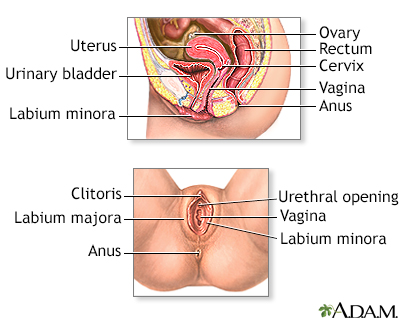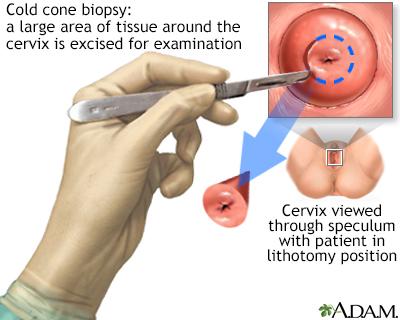Cone biopsy
A cone biopsy (conization) is surgery to remove a sample of abnormal tissue from the cervix. The cervix is the lower part of the uterus (womb) that opens at the top of the vagina. Abnormal changes in the cells on the surface of the cervix is called cervical dysplasia.
Cervical dysplasia
Cervical dysplasia refers to abnormal changes in the cells on the surface of the cervix. The cervix is the lower part of the uterus (womb) that open...

How the Test is Performed
This procedure is done in the hospital or in a surgery center. During the procedure:
- You will be given general anesthesia (asleep and pain-free), or medicines to help you relax and feel sleepy.
- You will lie on a table and place your feet in stirrups to position your pelvis for exam. The health care provider will place an instrument (speculum) into your vagina to better see your cervix.
- A small cone-shaped sample of tissue is removed from your cervix. The procedure may be performed using a wire loop heated by electrical current (LEEP procedure), a scalpel (cold knife biopsy), or a laser beam.
Cervix
The cervix is the lower end of the womb (uterus). It is at the top of the vagina. It is about 2. 5 to 3. 5 centimeters (1 to 1. 3 inches) long. Th...
 ImageRead Article Now Book Mark Article
ImageRead Article Now Book Mark Article - The cervical canal above the cone biopsy may also be scraped to remove cells for evaluation. This is called an endocervical curettage (ECC).
- The sample is examined under a microscope for signs of cancer. This biopsy may also be a treatment if the provider removes all of the diseased tissue.
Most of the time, you will be able to go home the same day as the procedure.
How to Prepare for the Test
You may be asked to not eat or drink for 6 to 8 hours before the test.
How the Test will Feel
After the procedure, you may have some cramping or discomfort for about a week. For about 4 to 6 weeks avoid:
- Douching (douching should never be done)
- Sexual intercourse
- Using tampons
For 2 to 3 weeks after the procedure, you may have discharge that is:
- Bloody
- Heavy
- Yellow-colored
Why the Test is Performed
Cone biopsy is done to detect cervical cancer or early changes that lead to cancer. A cone biopsy is done if a test called colposcopy cannot find the cause of an abnormal Pap smear.
Colposcopy
A colposcopy is a special way of looking at the cervix. The cervix is the lower part of the uterus (womb) that opens at the top of the vagina. Abno...

Cone biopsy may also be used to treat:
- Moderate to severe types of abnormal cell changes (called CIN II or CIN III)
- Very early stage cervical cancer (stage 0 or IA1)
Cervical cancer
Cervical cancer is cancer that starts in the cervix. The cervix is the lower part of the uterus (womb) that opens at the top of the vagina.
 ImageRead Article Now Book Mark Article
ImageRead Article Now Book Mark Article
Cervical cancer - Animation
Worldwide, cervical cancer is the third most common type of cancer in women. Luckily, it's much less common in the United States due to women receiving recommended routine Pap smears, the test designed to find cervical cancer sometimes even before abnormal cells turn to cancer. Cervical cancer starts in the cells on the surface of the cervix, the lower portion of the uterus. There are two types of cells on the surface of the cervix, squamous and columnar. Most cervical cancers come from these squamous cells. The cancer usually starts very slowly as a condition called dysplasia. This precancerous condition can be detected by Pap smear and is 100% treatable. Undetected, precancerous changes can develop into cervical cancer and spread to the bladder, intestines, lungs, and liver. It can take years for these precancerous changes to turn into cervical cancer. However, patients with cervical cancer do not usually have problems until the cancer is advanced and has spread. Most of the time, early cervical cancer has no symptoms. Symptoms of advanced cancer may include back pain, bone fractures, fatigue, heavy vaginal bleeding, urine leakage, leg pain, loss of appetite, and pelvic pain. If after having a Pap smear, the doctor finds abnormal changes on the cervix, a colposcopy can be ordered. Using a light and a low-powered microscope, the doctor will view the cervix under magnification. The doctor may remove pieces of tissue, called a biopsy, and send the sample to a laboratory for testing. If the woman is diagnosed with cervical cancer, the doctor will order more tests to determine how far the cancer has spread. This is called Staging. Treatment will depend on the stage of the cancer, the size and shape of the tumor, the woman's age and general health, and her desire to have children in the future. Early cervical cancer can be treated with surgery just to remove abnormal tissue, freeze abnormal cells, or burn abnormal tissue. Treatment for more advanced cervical cancer may include radical hysterectomy, removal of the uterus and much of the surrounding tissue, including lymph nodes and the upper part of the vagina. Radiation may be used to treat cancer that has spread beyond the pelvis, or if cancer returns. The woman may also have chemotherapy to kill cancer cells. Almost all cervical cancers are caused by human papilloma virus, or HPV. This common virus is spread through sexual intercourse. HPV vaccines can prevent infection. Practicing safe sex also reduces the risk of getting HPV. But, keep in mind most women diagnosed with cervical cancer have not had their regular Pap smears. Because Pap smears can find precancerous growths that are 100% treatable, it's very important for women to get Pap smears at regular intervals.
Normal Results
A normal result means there are no precancerous or cancerous cells in the cervix.
What Abnormal Results Mean
Most often, abnormal results mean that there are precancerous or cancerous cells in the cervix. These changes are called cervical intraepithelial neoplasia (CIN). The changes are divided into 3 groups:
- CIN I -- mild dysplasia
- CIN II -- moderate to marked dysplasia
- CIN III -- severe dysplasia to carcinoma in situ
Abnormal results may also be due to cervical cancer.
Risks
Risks of cone biopsy include:
- Bleeding
- Incompetent cervix (which may lead to premature delivery)
- Infection
- Scarring of the cervix (which may cause painful periods, premature delivery, and difficulty getting pregnant)
- Damage to the bladder or rectum
Cone biopsy may also make it hard for your provider to interpret abnormal Pap smear results in the future.
Reviewed By
LaQuita Martinez, MD, Department of Obstetrics and Gynecology, Emory Johns Creek Hospital, Alpharetta, GA. Also reviewed by David C. Dugdale, MD, Medical Director, Brenda Conaway, Editorial Director, and the A.D.A.M. Editorial team.
Cohen PA, Jhingran A, Oaknin A, Denny L. Cervical cancer. Lancet. 2019;393(10167):169-182. PMID: 30638582 pubmed.ncbi.nlm.nih.gov/30638582/.
Salcedo MP, Phoolcharoen N, Schmeler KM. Intraepithelial neoplasia of the lower genital tract (cervix, vagina, vulva): etiology, screening, diagnosis, management. In: Gershenson DM, Lentz GM, Valea FA, Lobo RA, eds. Comprehensive Gynecology. 8th ed. Philadelphia, PA: Elsevier; 2022:chap 29.
Watson LA. Cervical conization. In: Fowler GC, ed. Pfenninger and Fowler's Procedures for Primary Care. 4th ed. Philadelphia, PA: Elsevier; 2020:chap 128.




 All rights reserved.
All rights reserved.